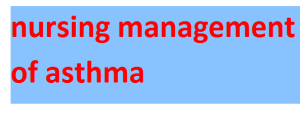nursing management of asthma 2024-2025
nursing management of asthma 2024-2025

Pathophysiology
Air passages become narrower as a result of bronchoconstriction, inflammation, and an increase in mucus production. This makes it harder to get air into the alveoli, which in turn makes it harder for red blood cells to exchange oxygen. The inability to exhale CO2, can also result in an increase in carbon dioxide (CO2) retention.
Etiology
An irritant or “trigger” can cause swelling and mucus to accumulate, resulting in breathing difficulties, wheezing sounds from the lungs, and hypoxia. Dust, pollen, smoke, and infections are all examples of triggers. Asthma can also be caused by allergies, environmental factors, exercise, or genetics.
Desired Outcome
the reduced effort required to breathe, adequate oxygenation and ventilation, and the perfusion of oxygen-rich blood into the tissues.
Asthma Nursing Care Plan
Subjective Data:
- “I can’t breathe”
- Chest Pressure
- Chest Pain
- Chest Tightness
- Reported Cough
Objective Data:
- Observed Cough
- Pursed lip breathing
- Low pulse oximetry (<90%)
- Blue lips/fingers
- Tachypnea
- Wheezing
- Tripod position
Nursing Interventions and Rationales
- Check pulse oximetryApply oxygen if O2 saturation is less than 90%, start at 2 liters nasal cannula (2L NC)
Collect subjective data to see if the patient is getting enough oxygen.
This helps the body physiologically as well as provides comfort. To put it another way, it cannot harm the patient, though it could do so at higher concentrations and flows. Eliminate hypoxia, increase by 1 L if they do not improve after a few minutes of rechecking, and contact respiratory therapy if they need more than 6 L NC.
- Auscultate lung sounds
They may require a bronchodilator if they wheeze.
If you hear crackles or rhonchi, the person may need suctioning because they may have pneumonia.
**Keep in mind that wheezes that go away do not always indicate improvement. It could indicate that the airway has narrowed more tightly, making it impossible to wheeze. Examine SpO2
- Inform on triggers. Check to see that there are no triggers in the patient’s room.
Dust is nearly impossible to completely eliminate, but there are other triggers like animal dander (no puppies visiting), pollen (no flowers), and so on. that can be removed.
Make sure the patient knows what triggers their asthma and help them figure out how to get rid of it from their life.
- putting the patient in a standing position
Opens lung bases and airway
- Perform a peak flow meter on the patient.
We can learn from peak flow meters how much air a patient can exhale. The less air they are moving, the smaller the number.
- Therapies for breathing and medication
- Beta-Agonists: Such as albuterol work as bronchodilators
- Anticholinergics: Such as Ipratropium work to relax bronchospasms
- Corticosteroids: Such as Fluticasone work as an anti-inflammatory
- Be prepared with an airway cart if the patient is a child or has been struggling to breathe for a long time and is getting worse. Also, keep your respiratory therapist aware of the patient for the love of the airway.
Safety! Additionally, you should not attempt to protect their airway until the imminent closure of their airways occurs. Sedation and intubation may be used to treat alkalosis or acidosis of the respiratory system.
Click here for South African Nursing Colleges and Schools Application 2023-2024
RELATED LINKS
Nursing Online Application links